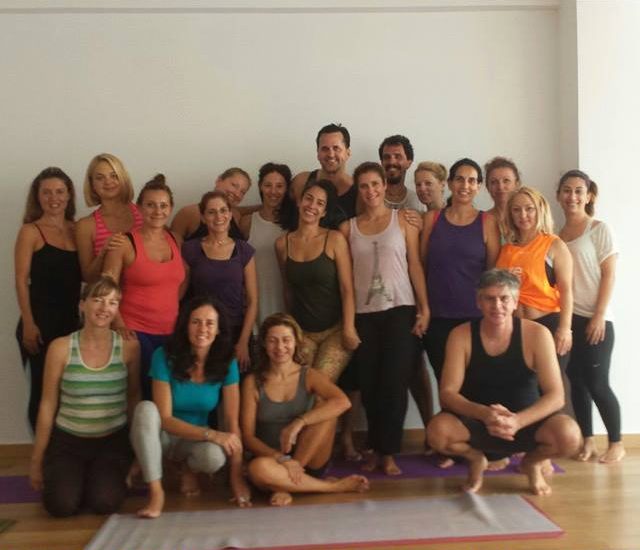How To Find The Right Yoga Teacher Training Program ~ Maya Devi Georg & Chris Kiran Aarya
 Yoga is more popular than ever, with studios in every neighborhood (and in some cases every block) many sincere students fall in love with the practice and long to share it with others.
Yoga is more popular than ever, with studios in every neighborhood (and in some cases every block) many sincere students fall in love with the practice and long to share it with others.
With CNN reporting the median income of a yoga teacher as a whopping $62,400 per year (a figure no real yoga teacher finds credible) many think that $3,000 – $15,000 for teacher training is an investment that will pay off in a big way.
Sadly, it may take years to earn back the money spent a yoga teacher training. And yet teaching yoga is one of the most rewarding experiences you can have and its positive impact on your life and practice is hard to measure.
Most studios are able to stay open only because of the revenue from the teacher training courses they provide. Considering that a studio can make $50,000 (or more) in one training, many studios see it as a great way to make money, and fast! Of course some studios hire their own graduates and many trainers sincerely want to offer a quality training and life-changing experience.
Not all trainings are equal! Some trainings can be very comprehensive and rigorous, giving you the skills, knowledge, and abilities you’ll need to get started as a teacher. Others may only deepen your practice, while some trainings and teachers are more interested in profits than in creating teachers capable of providing safe and interesting classes.
So, how can you find the right teacher training program?
With so many options out there, here are a few things to consider to make sure you’re signing up for the right training and to getting an experience that gets you ready to teach and deepen your own practice:
Content:
Is there a syllabus and reading list? This may sound obvious, but we have seen trainings that had no actual plan and relied on students asking the trainers for what subject they wanted covered, or other trainings that had students “meditating” eight hours a day with no instruction.
While the previous examples are rare, most teacher trainings certify trainees in one set sequence. It is the same poses in the same order, and you might get a chance to teach it once or twice during the training. Often adjustments, contraindications, and the anatomy of the asanas are completely omitted or barely addressed. They might include a cursory glance at the Yoga Sutras of Patanjali and/or the Bhagavad Gita, but more often than not new graduates are unaware of the difference between Hatha and Raja yoga.
Also, most trainings have specializations they cover. One may focus heavily on philosophy, while others on nutrition, alignment, ayurveda, or aromatherapy. Some may omit traditional anatomy and physiology and only teach subtle anatomy, lecturing on nadis, chakras, and prana.
It’s also important to know how many hours you’ll actually get to practice teaching and get feedback from the trainers on your practice teaching – you’d be surprised at how many yoga teacher trainings barely let the students practice teaching. On the other hand, the better ones will have you practice teaching early and often – and with plenty of constructive feedback.
The best advice we can give for those shopping around for a training is to ask for a copy of the syllabus, the book list, as well as a sample breakdown of the training by day or weekend. This should let you know if you will get the training you want!
Time:
How much time can you dedicate to a training? This is the biggest issue for most adults. We all have work/school/family obligations. How many hours and what kind of schedule can you commit to?
Month long retreat style trainings in exotic locations can be wonderful, immersive, and a great chance to focus completely on your training. But these may not be feasible for parents or those on a tight budget who can’t miss a month of work. Other trainings meet weekly, or are structured over a series of weekends spread over many months. So, make sure the scheduled dates and times of the training you are looking at is one you can commit to – and finish.
Currently, many training programs have moved online. This makes becoming a yoga teacher infinitely more accessible as you can be trained from the comfort of your own home, and at more convenient times.
However, learning various aspects of yoga and yoga asana are purely experiential – such as adjustments and corrections, as well as variations of poses for special needs – and need to be learned in person. If you choose an online training, be prepared to continue your education with in person workshops or retreats to gain the knowledge and experience you may have missed out on online.
Contact Hours :
You must also consider the number of contact hours you are paying for (those are the number of hours you get with trainers). Obviously fewer hours means less training so skip the week-long teacher trainings. There aren’t 200 hours in a week even if time spent sleeping counts as “yoga nidra.” If you aren’t getting the required hours, you sure aren’t getting adequate training.
Cost:
How much can you spend? The average cost of a training is $3-5,000. Do not take a training you cannot afford and do not borrow money to attend a training thinking you can earn it all back. It can take years to earn the cost of a teacher training by just teaching yoga. If you are considering taking a training ask if they have scholarships or work-study options for a reduced rate, and get any agreement in writing.
Be sure to calculate the cost of books as well as travel required for the training. There are often many hidden costs in training programs, with some programs requiring uniforms, books, and props be purchased by trainees. Ask ahead so that you can be prepared to cover all costs of a program.
Style & Sequence:
Chances are you will know the style of the training you are signing up for but some styles like vinyasa can be open to interpretation so you may not get what you expect. It’s important to know if you will be taught only one sequence of asanas, or if you will be taught how to create your own sequences.
Yoga Alliance is only a registry and it is the school that graduates you that certifies you as a credible teacher. If you are only trained to teach one sequence, you are not going to be ready to teach anything else. If you love that one sequence and believe that it is all you or your students need, go for it. But, if you want more freedom to create your sequences, find a training that will enable you to do that.
Trainers:
Who is training you? What levels of training have they completed? Always take some classes from the person training you and if you can’t get to their class find other graduates of that training and take their class. If they have done any writing on yoga, read it and see if it resonates with you.
Talk to the trainers. Get to know them. You will be spending a lot of time listening and interacting with these teachers, it helps if you like them! But just as important is knowing they can get you ready to teach! Ask the trainers who they trained and studied with, and how long they have been teaching and training teachers.
When looking for a teacher trainer, experience and references count a lot more than a hot body or flawless practice.
Of course, there are also the celebrity yoga teachers that conduct yoga teacher trainings. Perhaps you’ve taken their workshops, watched videos or their Instagram feed, or have studied their style. When signing up for their training you may want to be sure you will actually be trained by them.
Some celebrity teacher trainings are conducted by the students of those famous teachers, and the teachers you hoped to meet and learn from appear only in pre-recorded video lectures. It is a good idea to ask what subjects those teachers will cover and how many hours they will be present and available before you register.
Yoga Alliance:
Yoga Alliance is a registry that outlines the minimum requirements for a yoga teacher training. Again, it is a registry; that means it is a list of teachers that have received trainings that adhere to those minimum standards, or that a Registered Yoga School will provide those minimum standards in a training.
These minimum standards exist because many trainings would provide far less if they could – and sadly even some Yoga Alliance trainings skirt many of these minimums – but this is something the new student feedback process is slowly fixing. Regardless of different opinions on Yoga Alliance it is the largest international organization that exists to provide a broadly accepted minimum standard for what is necessary to teach yoga.
Is Yoga Alliance necessary? It depends…
Being a Registered Yoga Teacher (RYT) through Yoga Alliance is sometimes required by gyms, schools, studios, as well as corporate clients, and other employers. A teacher can still be hired by many organizations without the RYT designation if they have a lengthy and stellar resume. But without that designation it can be difficult to get that experience.
Being a Registered Yoga School usually insures that the trainers have received multiple trainings themselves and met certain standards in order to be a trainer or lead trainer for a YTT. And, yes, we have seen completely untrained individuals with little to no knowledge of yoga successfully fool people into spending thousands of dollars on a YA-approved course that ultimately does not prepare them to teach. We’ve also seen superb YTT programs that are not part of Yoga Alliance but turn out excellent teachers.
We’ve also seen schools claiming to be a Registered Yoga School (RYS) with Yoga Alliance when they were not. There are even a few yoga schools misleading their students by claiming that a 60-100 hour ‘immersion’ or ‘intensive weekend’ is the equivalent of a Yoga Alliance approved training. People who run yoga schools are human which means they are imperfect and susceptible to the temptations of greed and cutting ethical corners. The key is to know what you are getting – and what you are not.
Luckily, it is easy to check if the school you are considering is a RYS, and the teachers running RYT’s by checking to see if they are listed on the Yoga Alliance website at www.YogaAlliance.org. In any case, whether it is a RYS or not, it’s a good idea to talk to a few graduates of the program to get a better idea if it is right for you. And just because one person may not speak well of it does not mean that its not right for you. Sometimes what they were looking for was not what you are looking for.
The practice of yoga is deeply personal and moving, but the business of yoga is still a business. It is important to do research to find what is right for you. If this seems overwhelming you can always ask your yoga teacher for recommendations, or help with choosing between a few trainings. Chances are there are people within your community who can help guide you to the proper path.
Yoga is a deeply emotional and personal practice and teaching yoga can be a deeply rewarding endeavor. The right yoga teacher training can transform not only your practice but also your life so do your homework and choose wisely!



